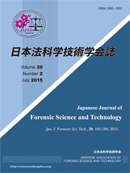Volume 20, Issue 2
Displaying 1-8 of 8 articles from this issue
- |<
- <
- 1
- >
- >|
Original Article
-
2015 Volume 20 Issue 2 Pages 103-112
Published: 2015
Released on J-STAGE: July 17, 2015
Advance online publication: January 30, 2015Download PDF (690K) -
2015 Volume 20 Issue 2 Pages 113-123
Published: 2015
Released on J-STAGE: July 17, 2015
Advance online publication: March 31, 2015Download PDF (769K) -
2015 Volume 20 Issue 2 Pages 125-140
Published: 2015
Released on J-STAGE: July 17, 2015
Advance online publication: May 08, 2015Download PDF (2526K) -
2015 Volume 20 Issue 2 Pages 141-155
Published: 2015
Released on J-STAGE: July 17, 2015
Advance online publication: June 15, 2015Download PDF (2260K)
Technical Note
-
2015 Volume 20 Issue 2 Pages 157-164
Published: 2015
Released on J-STAGE: July 17, 2015
Advance online publication: June 15, 2015Download PDF (761K) -
2015 Volume 20 Issue 2 Pages 165-173
Published: 2015
Released on J-STAGE: July 17, 2015
Advance online publication: June 15, 2015Download PDF (376K)
Note
-
2015 Volume 20 Issue 2 Pages 175-183
Published: 2015
Released on J-STAGE: July 17, 2015
Advance online publication: February 17, 2015Download PDF (278K) -
2015 Volume 20 Issue 2 Pages 185-189
Published: 2015
Released on J-STAGE: July 17, 2015
Advance online publication: June 15, 2015Download PDF (562K)
- |<
- <
- 1
- >
- >|
